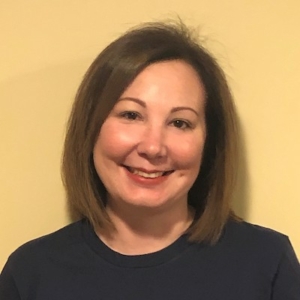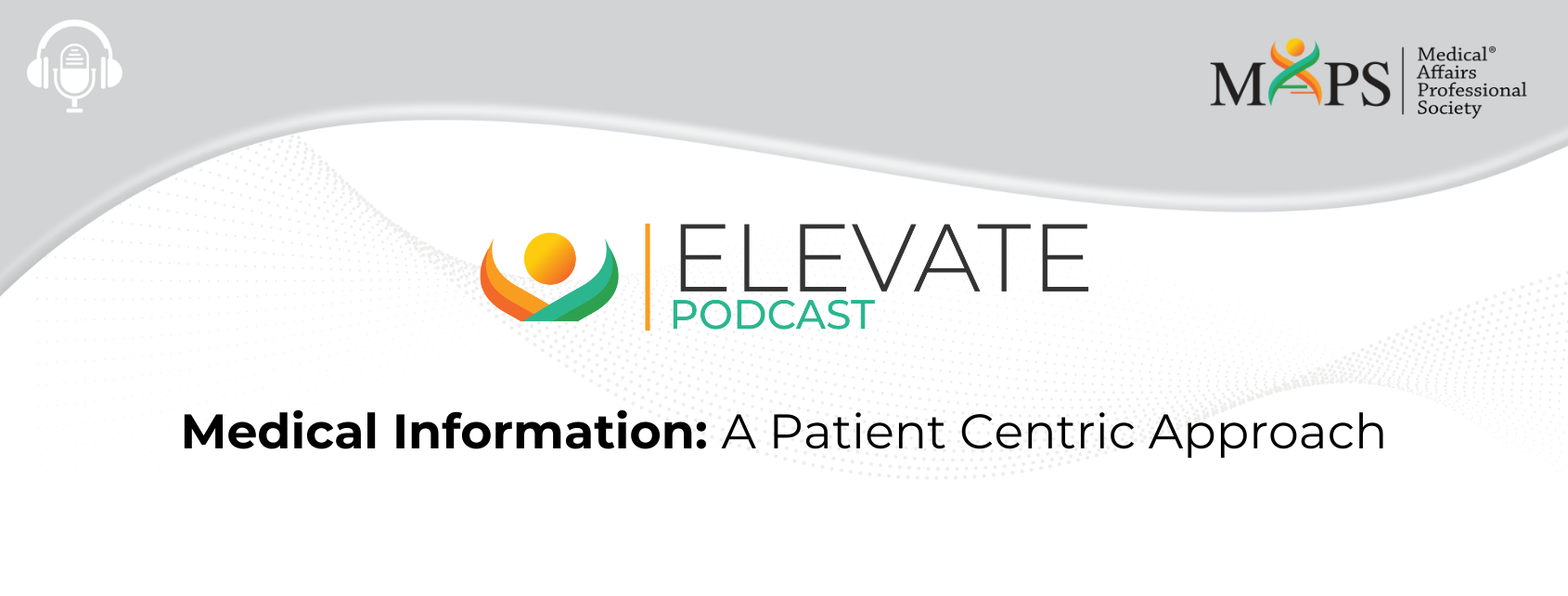Medical Information: A Patient Centric Approach
Objectives
At the end of this series of podcasts, the participant should be able to:
- Understand the core goals and activities that support patient centricity within Medical Information
- Discuss how Medical Information colleagues can support patient-centric initiatives
- Provide examples of Medical Information patient strategy activities

INTERVIEWER: Michelle Quinlan


INTERVIEWER: Prachi Parmar


INTERVIEWEE: Sraddha Wadhwa

Following is an automated transcription provided by otter.ai. Please excuse inaccuracies.
Michelle Quinlan 0:00
Welcome to the medical affairs professional societies medical information focus area working groups, three part podcast series on patient engagement. In today’s first podcast we will discuss patient centricity with medical information and approaches to improve patient engagement and experiences. I am Michelle Quinlan. I’ll be the moderator for this podcast. I currently served as an Associate Director of medical information at Pfizer. The views expressed in this recording are those of the individuals and do not necessarily reflect on the opinions of maps, or the companies with which they are affiliated. This presentation is for informational purposes only and is not intended as legal or regulatory advice. We encourage you to engage in conversations about patient centricity with other maps members via max connect on the maps website or mobile app. Simply login with the email address and password associated with your maps account and access the maps global community. Then click on the discuss tab and scroll down to patient centricity to post a question or review previous postings. today’s podcast objectives are to understand the core goals and activities that support patient centricity within medical information to discuss how medical information colleagues can support patient centric initiatives, and finally to provide examples of medical information patient strategy activities. I’d like to thank today’s panelists for sharing their subject matter expertise with the maps membership. speaking today are Prachi Parmar, Associate Director of medical information at Pfizer, and trata Wadler, Director of medical information at Pfizer. You both please briefly provide information on your current position Prachi
Prachi Parmar 1:49
Yeah, sure. Hey, Michelle. Hi, everyone. My name is Prachi Parmar and I have spent a large part of my career in medical information at Pfizer, supporting a variety of therapy areas and products. Prior to that I’ve had experience in the long term care setting, and today I currently support a large portfolio of products in the hospital business unit.
Sraddha Wadhwa 2:14
Hi, everyone. My name is shraddha Wadhwa, I serve as a compliance focus area director at Pfizer medical information. I’ve been at Pfizer for over 10 years now. And I currently support the internal medicine Rare Disease portfolio.
Michelle Quinlan 2:29
Great, thank you both so much. Well, it’s so exciting to be here today speaking about a topic that we are so passionate about. Across the healthcare spectrum, patient engagement continues to grow and evolve with increased activity identified in several areas such as searching for care and accessing new channels. This is such an important focus industry wide, and it has become increasingly important to evaluate and develop strategies and tools that might help patients continue to improve engagement in their health. As medical information professionals, gathering information from patient insights may also help us better understand the patient journey and improve the overall patient experience. Remember, when our patient engagement and strategy team began, it was so important for us to improve engagement and really aim for more patient centric approach. As we dug deeper into what we actually wanted to accomplish. The medical information patient strategy was developed to incorporate the voice of the patient to best meet their needs, and also to create an excellent customer experience.
Prachi Parmar 3:31
Thanks, Michelle, you know, and as a part of the development of our global patient strategy, the team considered the following questions. Number one, what if we let the voice of the patient be heard? And number two? What if we can use patient’s feedback to improve products, packages, information and communication? The team evaluated the need to advance colleagues skills for insight generation, and focus on the patient journey, promote humanized care and empathy and garner a solid understanding of health literacy concepts.
Michelle Quinlan 4:04
Right, and our overall strategy contains many facets and we keep on striving to do more trata you’ve also been working with us on so many innovative projects. Can you also highlight a little more about what our patient engagement focus is? Sure, no problem Michelle.
Sraddha Wadhwa 4:18
The core of our patient strategy includes the following principles transform the way we engage with patients and physicians enhance health outcomes and patient experiences, be known as the most patient centric company drive pro innovation and pro patient policies. The summarize the aim of our patient strategy serves to amplify the patient voice within the company influence outcomes that will benefit patients and work to meet their information needs channels that are easy to access and easy to use. The three main principles would be to one listen to meet the needs of our patients. And three provide a great experience which are essentially the main objectives of our three part podcast.
Michelle Quinlan 5:00
Thanks, Radha. I think it’s also really important to highlight some of what was initially worked on so we can explain this journey that we’ve been on. We went into this, you know, aiming for success. However, To accomplish this, we needed to understand the current landscape across the industry.
Prachi Parmar 5:17
Yeah, and remember, in order for us to better understand this landscape, we initiated that benchmarking study within Pfizer medical information. And we evaluated patient empowerment, and the accessibility of patient resources from 27 different pharmaceutical company websites. When we looked at the results, we saw that 85% of companies provided access to a phone number for consumers to call back within three clicks. And 55% provided patients with an online submission portal or an email address, again, within three clips. So a clear opportunity existed to improve the availability of and enhance patient resources to help empower patients to seek out the information that they’re interested in.
Michelle Quinlan 6:06
Yeah, and you know, in this initial research, it was it was part of the whole basis to support the development of a dedicated patient website for medical information. trata. I’ll let you speak a little more about that. But before I do, please don’t forget to mention the large number of site visits that we’ve had as well.
Sraddha Wadhwa 6:21
I definitely our site visits have been on an upward trajectory with over 10,000 visits per month for certain products, which is absolutely amazing. I’ll tell you a little bit about the evolution of our patient portal. So back in 2013, the patient portal was launched as a new medical information resource designed for us patients and caregivers, visitors to WWW dot Pfizer med info.com with self certify whether they are hcps are patients and caregivers, and then they’re directed to the appropriate portal. As you remember, initially, our medication page pages focus on content from the product medication guides. But then in November 2018, medical information launched the patient response documents also known as PR DS, which were published on the portal for customers to view and for us call centers to utilize and answering patient questions as, as applicable, aligned with our customer needs. A patient guided chatbot was also designed to help users navigate general resources such as obtaining information on patient assistant programs. To your point about metrics Michelle, a recent survey indicated that 92% of our site visitors visited the site seeking information versus searching for a phone number to speak with someone. This data reinforces the fact that our portal is helping us further engage patients where they are seeking information about their medication.
Michelle Quinlan 7:44
Thanks, Radha. So throughout the course of 2018, the global patient content team undertook a thoughtful and focused approach with respect to the development of patient content, we went through, you know, several different phases, the first of which being the learning phase. So the learning phase consisted of looking at strategies directed towards evaluating the current landscape, reviewing our inquiry, volume and understanding the value add and also any type of legal and regulatory restrictions that might prohibit us from moving forward. Then second, we looked at objective setting. So our objectives consisted of the development of a patient global style guide, the creation of an optimal PRD format, and finally developing sample PRD. Finally, we had our action and achievement phase. And this was the finalization of a PRD standard template, the style guide development, including language and disclaimers that we needed to include, and finally the launch of PRD in the US.
Prachi Parmar 8:45
So it should also be noted that, you know, in addition to all of that, our patient Strategy Team members had to learn about health literacy during this time. And these these concepts were applied to rprd. health literacy, it’s the degree in which individuals have the capacity to obtain process and understand basic health information and services needed to make appropriate health decisions. Considering the impacts of health literacy, medical information embarks on an endeavor to develop more patient centered response documents. Our planning and actions were intended to be mindful of the needs and expectations of our patients and how critical it is to their treatment adherence and compliance. The effective development of medical information prts required a thoughtful approach and the concept of health literacy was highly considered throughout this process. Implementation of prts as a part of our overall patient strategy has offered medical information the opportunity to provide patient focused materials to those seeking products information. Sharla what were some of those key principles that we had to incorporate
Sraddha Wadhwa 9:58
Sure. Prachi Some of the key principles of parties that have been incorporated into this format include focus content specific to the topic and scope of the question. relevant information from the local prescribing information is included but in a concise manner, content is presented in a six to eighth grade literacy level. And it’s important that content should use just plain language and from an easy to access easy to use mentality. As I mentioned previously, our approved responses are accessible via the patient portal on www dot Pfizer med info.com. And our frontline constant contact centers can fulfill increase with these responses by phone mail and email channels.
Michelle Quinlan 10:41
Wow, I just think it’s you know, it’s so apparent that as a customer facing organization, medical information continues to demonstrate leadership through enhancing the patient experience. Given m eyes unique position, we are, you know, poised to support further opportunities to collaborate with our stakeholders in the patient space. medical information is continuing to serve as a leader in engaging in patient centric initiatives. Thank you so much to our speakers, Prachi and strada. This has been the first podcast in a series on the topic of patient engagement. If you are a maps member, thank you for your support of maps. If you are not yet a maps member, I would like to access additional resources in this area. Please visit the maps website to explore joining today at medical affairs.org slash forward slash membership. This concludes our podcast Thank you



